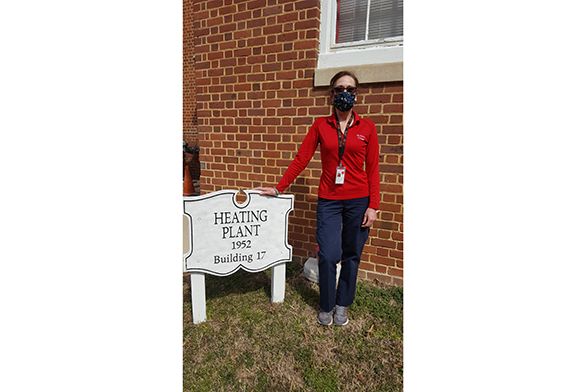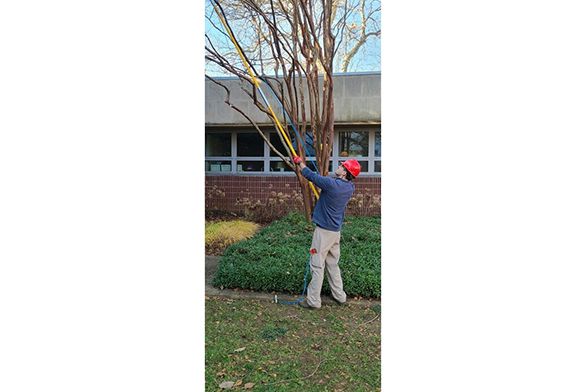Annapolis Frontline Workers Keep Campus Running
March 18, 2021 | By Les Poling

Monica Jones can clearly recall the uncertainty and turmoil of March 2020—specifically, the week of March 9. St. John’s students had departed campus for two weeks of spring break; small groups of international students were still living in college dorms, while staff members continued in-person work. Then, in the span of days, the World Health Organization declared the novel coronavirus a pandemic, state governments across the country announced lockdowns, and—most immediately impactful for Jones and the rest of the college community—St. John’s closed both its campuses for the remainder of the semester.
“Right when it happened, my boss, JR Pappas, told us to stay home,” remembers Jones, who works as the administrative assistant for the St. John’s Annapolis buildings and grounds department. “In the beginning, when all the kids were off campus, we didn’t know what this was, really.”
To this day, a large portion of St. John’s employees are working remotely, and the pandemic forced the college online for the fall 2020 semester. But back in spring 2020, Jones was back at her desk within weeks. As the United States surpasses a year of COVID-impacted life, St. John’s College’s frontline workers—including members of buildings and grounds, public safety, and more—have been working consistently throughout the last 12 months to keep campus running and provide the community with essential services.
For buildings and grounds employees and public safety officers, day-to-day work resumed almost immediately following campus closure—albeit with new social distancing and masking protocols. “If I remember correctly, we [buildings and grounds] experienced reduced hours for several weeks, and worked our way back up to full-time not long after,” says Groundskeeper Joseph Malfitano (AGI21) of the initial COVID-19 lockdown.
Jones describes a similar experience. As administrative assistant, she fields service requests, coordinates buildings and grounds tasks, and communicates with the larger campus community. While such tasks became less frequent, they still continued. Meanwhile, for groundskeepers like Malfitano, the outdoor nature of the work was a welcome boon. Ordinary tasks include everything from trash and recycling disposal to pruning trees, moving furniture, weed whacking, and snow removal. “Our work being primarily outdoors, much has stayed the same,” Malfitano notes, although “we’re in the dorms collecting trash less than has typically been the case.”
“The opportunity to work in person and mostly outdoors has been a great gift,” he continues. “Getting to talk with coworkers face-to-face and being out and about on campus helps allay some of the stir-crazy.”
CET Supervisor Raymond Logan, a 14-year employee of the college, explains that he’s been working on campus since March; along with his usual supervising duties, he took on the responsibility of implementing safety precautions for his crew. “The thing that changed the most [since last March] was the disinfecting and safety measures. For the most part, everything stayed the same.”
He adds: “I am just trying to keep everyone safe.”
According to Officer Eric Lane and Sergeant Carey Gordon, public safety officers never experienced a decline in hours. “Public safety continued to operate and provide on-campus services 24/7,” Gordon says, though he recalls “[wondering] how the college would adapt, what changes were going to have to be made for the health and safety of the community.”
Officer Lane works overnights at the college, where an average shift entails patrolling campus, answering calls, and—most importantly—interacting with students and members of the campus community. His work wasn’t drastically disrupted by the college’s transition to remote learning; however, there was a certain element of loss.
“The mindset early on wasn’t much different from breaks between semesters—as per what we all expect, it gets quiet around here once the students have left,” Lane explains. But “the more time dragged on, we began to miss our community that much more.”
Jones puts it simply: “Campus was like a ghost town.”

Of course, campus wasn’t entirely empty. There were small numbers of international Johnnies living in the dorms, and on-campus staff dedicated themselves to safely helping those students in any way possible. Additionally, “it seems almost surreal to me, but the school housed several hundred U.S. Naval Academy midshipmen in the fall,” Malfitano points out. “It was interesting to get a glimpse into the lives of the students there.”
But the midshipmen simply weren’t Johnnies, according to Jones. Whereas St. John’s students take to back campus for intramurals and croquet, congregating in the quad to read and conversate, the mids largely kept to their dorms whenever they weren’t in transit to or from the academy. “They were just sleeping here,” she explains.
It’s now March 2021, and COVID-19 is still ever-present in American life. However, this March is radically different than the last one for St. John’s students, faculty, and frontline staff. The college has reopened its doors, allowing students back on campus with mandated weekly COVID-19 testing, symptom tracking, mask wearing, and social distancing. The mood among the college’s essential workers is one of excitement and relief.
“I think it’s great that the students are coming back,” Logan says. Likewise, Officer Lane and Sergeant Gordon each believe that—if all community members follow the required safety protocols—life at the college can soon return to something that more closely resembles ordinary life; something they each eagerly anticipate.
“I am personally excited to have our community return to campus. I know not only myself but other colleagues have missed the interaction,” Lane says. “I am excited for those returning and cannot wait for us to get back to a little bit of normalcy.”
Most of all, Jones says, the college only feels like the college when there are Johnnies around; walking, talking—even from behind a mask—and (of course) reading. “I feel like this is where they belong,” she concludes. “We’re all ready to have them back.”

